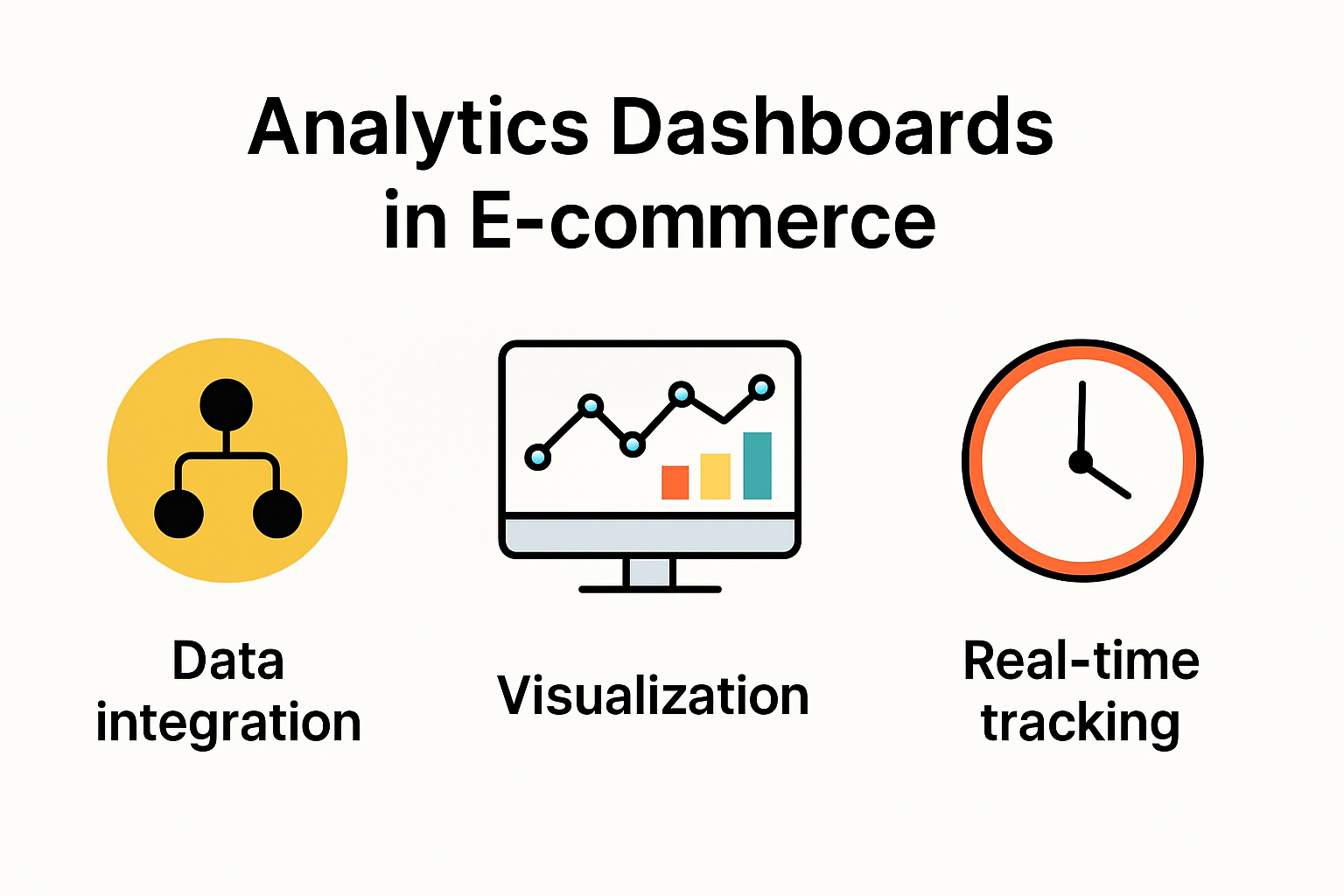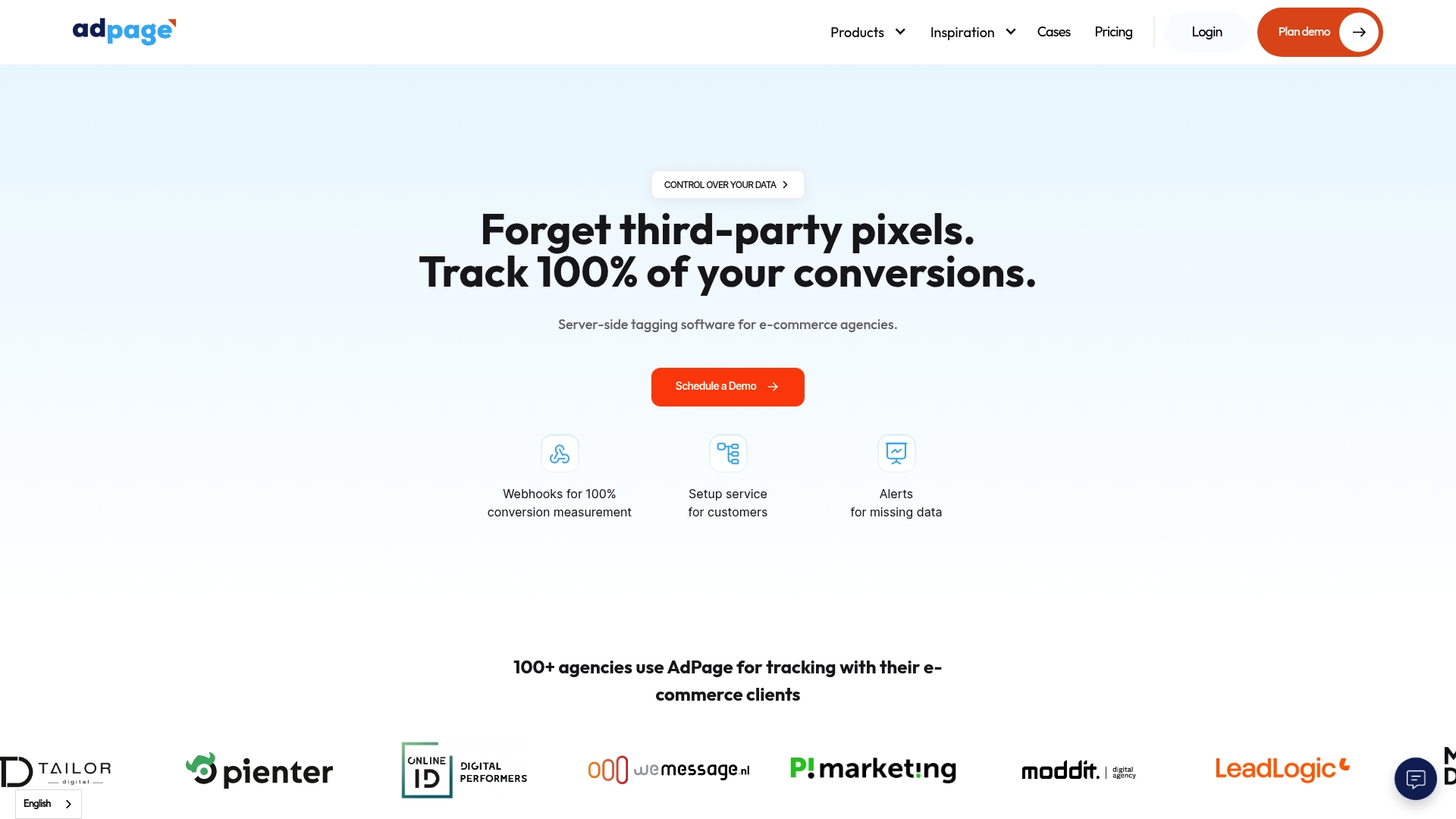Ecommerce competition moves faster every year and the difference between thriving and stalling often comes down to how well you read your own numbers. Believe it or not, businesses using analytics dashboards see their decision-making speed shoot up by as much as 67 percent. Yet, the biggest surprise is that simply having data is not enough. The real winners this year are those who turn their dashboards into living, interactive tools that actually push their strategy forward, not just display yesterday's results.
Table of Contents
- Understanding Analytics Dashboards For Ecommerce
- Setting Up Dashboards For Conversion Optimization
- Key Metrics Every Marketer Should Track
- Best Practices For Actionable Insights In 2025
Quick Summary
| Takeaway | Explanation |
|---|---|
| Analytics Dashboards Enhance Decision-Making. | Centralized dashboards consolidate diverse data streams, improving decision-making speed by up to 67% with easy-to-understand visuals. |
| Focus on Critical Metrics for Conversion | Key metrics, such as conversion rate and cart abandonment rate, must align with business goals to effectively optimize online performance. |
| User-Friendly Design is Crucial | Clarity and simplicity in dashboard design enhance usability, ensuring that metrics are presented without overwhelming the users. |
| Interactive and Dynamic Features are Essential | Dashboards should allow users to explore data interactively, enabling deeper insights through customization and real-time data updates. |
| Continuous Optimization Drives Success | Regular feedback and iterative design processes are necessary to ensure dashboards evolve with changing business needs and technologies. |
Understanding Analytics Dashboards for Ecommerce
Analytics dashboards are powerful visual tools that transform complex e-commerce data into actionable insights. These comprehensive platforms aggregate critical performance metrics, enabling businesses to make data-driven decisions rapidly and strategically.

The Core Purpose of E-commerce Analytics Dashboards
At their essence, analytics dashboards serve as centralized command centers for online businesses. They consolidate multiple data streams from various sources such as website traffic, sales performance, customer behavior, and marketing campaigns into a single, intuitive interface. Gartner Research highlights that effective dashboards can improve business decision-making speed by up to 67% by presenting complex information in easily digestible visual formats.
Modern e-commerce dashboards go beyond simple number reporting. They provide real-time performance tracking, allowing businesses to monitor key performance indicators (KPIs) instantaneously. This means you can track metrics like conversion rates, average order value, customer acquisition costs, and website traffic in a single glance.
Critical Components of Effective E-commerce Dashboards
Successful analytics dashboards are not just about displaying data but presenting it in a meaningful, actionable manner. Netsuite recommends several critical components for creating powerful e-commerce analytics dashboards:
- Data Visualization: Transforming raw numbers into graphs, charts, and interactive visualizations that make trends and patterns immediately apparent.
- Customization Capabilities: Allowing users to configure dashboards according to specific business needs and priorities.
- Comprehensive Metric Coverage: Integrating multiple data sources to provide a holistic view of business performance.
Implementing real-time alerts is another crucial feature. These notifications enable teams to promptly address emerging issues, preventing minor problems from escalating. By setting up automated alerts for significant changes in key metrics, businesses can maintain proactive operational control.
Designing User-Friendly Analytics Dashboards
The effectiveness of an analytics dashboard hinges on its usability. McKinsey Digital emphasizes that dashboard design should prioritize clarity and simplicity. This means avoiding information overload by carefully selecting and organizing metrics.
Key principles for creating user-friendly dashboards include:
- Limit the number of displayed metrics
- Use consistent, intuitive color schemes
- Arrange information in logical, hierarchical structures
- Provide context for numerical data
Regular review and assessment of dashboard effectiveness ensure that the displayed information continues to support evolving business goals. As e-commerce landscapes change, so too should the metrics and visualizations that guide strategic decision-making.

By understanding and implementing robust analytics dashboards, e-commerce businesses can transform raw data into strategic insights, driving growth, optimizing performance, and staying ahead of competitive markets.
To help clarify what makes up a powerful ecommerce analytics dashboard, the following summary table outlines the critical dashboard components and their descriptions as discussed above.
| Component | Description |
|---|---|
| Data Visualization | Raw numbers presented as graphs, charts, and interactive visuals for quick insight |
| Customization Capabilities | Ability to tailor the dashboard to specific business needs and priorities |
| Comprehensive Metric Coverage | Integrates multiple sources for a holistic business overview |
| Real-Time Alerts | Automated notifications for rapid response to significant changes in key metrics |
Setting Up Dashboards for Conversion Optimization
Conversion optimization dashboards are strategic tools that transform raw data into actionable insights, enabling e-commerce businesses to systematically improve their online performance. These specialized dashboards provide a comprehensive view of user interactions, helping teams identify and address barriers to successful conversions.
Identifying Critical Conversion Metrics
Successful conversion optimization begins with selecting the right metrics. ResearchGate emphasizes that dashboards must align closely with strategic business goals, ensuring metrics are not just numbers, but meaningful indicators of performance.
Key metrics to track include:
- Conversion Rate: The percentage of visitors who complete a desired action
- Cart Abandonment Rate: Percentage of users who add items to cart but do not complete purchase
- Average Order Value: Total revenue divided by number of orders
- Traffic Source Performance: Understanding which channels drive most valuable traffic
Implementing Advanced Analytics Integration
Predictive analytics research highlights the importance of integrating sophisticated data processing tools. This involves creating dashboards that not only report historical data but also provide forward-looking insights.
Advanced integration strategies include:
- Connecting multiple data sources
- Implementing machine learning algorithms
- Creating predictive conversion models
- Developing real-time performance tracking
Optimising Dashboard User Experience
Arxiv research underscores the significance of understanding user interactions across different platforms. This means designing dashboards that provide insights into mobile performance, browser compatibility, and cross-device user journeys.
Effective dashboard design requires:
- Intuitive visual representations
- Responsive design for multiple devices
- Clear, actionable data visualizations
- Customizable views for different team roles
By implementing a well-structured conversion optimization dashboard, businesses can transform complex data into strategic insights, enabling continuous improvement and more informed decision-making processes. The key is to create a dynamic, adaptable tool that evolves with your e-commerce strategy.
To make it easier to reference the most critical conversion metrics mentioned, here is a table summarizing their purpose for e-commerce optimization.
| Metric | Purpose |
|---|---|
| Conversion Rate | Measures percentage of visitors completing a desired action |
| Cart Abandonment Rate | Identifies friction in the purchase process |
| Average Order Value | Tracks average revenue generated per order |
| Traffic Source Performance | Reveals most valuable channels bringing in site visitors |
Key Metrics Every Marketer Should Track
E-commerce marketers navigate complex digital landscapes by leveraging critical performance metrics that reveal the health and potential of their online businesses. Understanding and tracking these key indicators provides strategic insights that drive informed decision-making and sustainable growth.
Performance and Conversion Metrics
Netsuite emphasizes the importance of tracking comprehensive performance indicators that go beyond surface-level numbers. Conversion Rate emerges as a pivotal metric, measuring the percentage of website visitors who complete a desired action, such as making a purchase.
Key performance metrics include:
- Conversion Rate: Indicates website effectiveness and marketing strategy efficiency
- Cart Abandonment Rate: Reveals potential friction points in the purchasing process
- Average Session Duration: Measures user engagement and content relevance
- Bounce Rate: Highlights potential issues with website design or user experience
Financial and Customer Value Metrics
Mailchimp recommends tracking financial metrics that provide deeper insights into business performance. Average Order Value (AOV) represents a critical indicator of customer spending patterns and marketing effectiveness.
Essential financial metrics marketers should monitor:
- Average Order Value
- Customer Acquisition Cost
- Revenue per Visitor
- Gross Profit Margin
Long-Term Customer Insights
ThoughtSpot highlights the significance of Customer Lifetime Value (CLV), a metric that estimates the total revenue a business can expect from a single customer over time. Understanding CLV helps marketers make strategic decisions about customer retention and marketing investments.
Comprehensive customer insight metrics include:
- Customer Retention Rate
- Repeat Purchase Rate
- Customer Lifetime Value
- Net Promoter Score
Successful e-commerce marketing requires a holistic approach to metrics tracking. By integrating these key performance indicators, marketers can develop nuanced strategies that drive growth, improve customer experience, and optimize overall business performance. The most effective dashboards transform these metrics from raw numbers into actionable insights that guide strategic decision-making.
Best Practices for Actionable Insights in 2025.
As e-commerce continues to evolve, developing analytics dashboards that generate truly actionable insights becomes increasingly critical. Successful businesses in 2025 will distinguish themselves by transforming complex data into strategic decision-making tools that drive meaningful growth and operational efficiency.
Creating Interactive and Dynamic Dashboards
Zoho emphasizes the importance of interactive dashboards that enable users to explore data dynamically. These advanced platforms go beyond static reporting, allowing team members to drill down into granular details, apply custom filters, and uncover nuanced insights.
Key features of interactive dashboards include:
- Customizable Views: Tailoring dashboards to specific user roles and responsibilities
- Real-Time Data Refresh: Ensuring metrics reflect the most current information
- Drill-Down Capabilities: Enabling deeper investigation of top-level metrics
- Cross-Platform Accessibility: Supporting mobile and desktop exploration
Implementing Robust Data Governance
Educause Research highlights eight critical attributes for effective data utilization: timeliness, consistency, trustworthiness, relevance, interactivity, connectivity, accessibility, and actionability. These principles form the foundation for developing analytics dashboards that drive strategic decisions.
Data governance best practices involve:
- Establishing clear data quality standards
- Implementing rigorous data validation processes
- Creating transparent data collection methodologies
- Ensuring comprehensive data security protocols
The eight attributes for effective data utilization are foundational to dashboard development. The table below summarizes these attributes for easy reference.
| Attribute | Focus Area |
|---|---|
| Timeliness | Data is up-to-date and current |
| Consistency | Data is uniform and standard across sources |
| Trustworthiness | Data is reliable and accurate |
| Relevance | Data aligns with business or user needs |
| Interactivity | Users can engage with and explore data |
| Connectivity | Data can be integrated from multiple sources |
| Accessibility | Data is readily available to users |
| Actionability | Data enables informed decision-making |
Continuous Dashboard Optimization
Arxiv Research underscores the significance of continuous usability testing and iterative design processes. Effective dashboards are not static tools but evolving platforms that adapt to changing business requirements and technological capabilities.
Strategies for ongoing dashboard optimization include:
- Regular user feedback collection
- Periodic performance audits
- Integration of emerging analytics technologies
- Alignment with evolving business objectives
Successful analytics dashboards in 2025 will transcend traditional reporting mechanisms. They will serve as strategic intelligence platforms that empower businesses to anticipate market changes, understand complex customer behaviors, and make data-driven decisions with unprecedented precision and confidence.
By embracing these best practices, e-commerce businesses can transform their analytics dashboards from passive reporting tools into dynamic strategic assets that drive innovation, efficiency, and competitive advantage.
Frequently Asked Questions
What are analytics dashboards in ecommerce?
Analytics dashboards in ecommerce are visual tools that transform complex data into actionable insights, allowing online businesses to centralize and monitor key performance metrics like sales, traffic, and customer behavior.
How do I optimize my ecommerce dashboard for conversions?
To optimize your ecommerce dashboard for conversions, focus on tracking critical metrics such as conversion rates, cart abandonment rates, and average order value, while ensuring the dashboard is user-friendly and allows for real-time updates and customization.
What key metrics should I track with my ecommerce analytics dashboard?
Key metrics to track include conversion rates, cart abandonment rates, average order value, traffic source performance, and customer lifetime value to assess both performance and financial health.
How can I make my analytics dashboard more user-friendly?
To enhance user-friendliness, limit the number of displayed metrics, organize information logically, use consistent color schemes, and provide context for data, ensuring that users can easily interpret the insights presented.
Make Every Ecommerce Metric Count with Accurate Tracking
Are you struggling to turn your analytics dashboards into a true engine for ecommerce growth? The article highlighted how incomplete data and reliance on old tracking methods can hold back real insight and slow down decisions. Too often, visitor journeys get lost in the gaps, making it almost impossible for marketing teams to increase conversion rates or prove their impact. If you feel your current setup leaves important customer actions untracked, or if you are frustrated by uncertainties in your reports, you are not alone. Many agencies and marketers are facing the same challenge of transforming raw numbers into actionable, reliable decisions.

Now is the time to take control and secure every conversion with certainty. AdPage gives you server-side tagging, privacy-compliant data, and 100 percent conversion monitoring, all built to work perfectly with platforms like Shopify and Magento. No more guesswork or missed sale opportunities. Experience onboarding assistance, automated consent management, and robust reporting tools, all tailored to help you unlock the full power of your analytics dashboards. Visit AdPage and start making clear, confident marketing decisions today.



.png)
